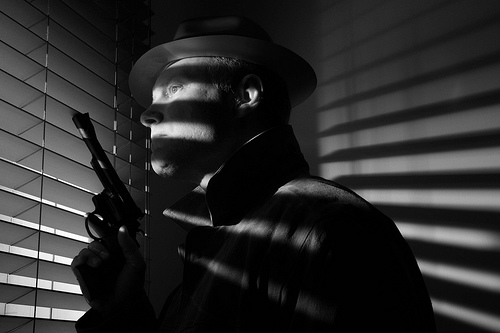Film Noir first dates back to 1946, where it officially became a term and a genre. Film Noir is the term used to describe stylish Hollywood crime drama films, typically laced with dark, low key lighting along with symbolic shadow placement and provocative female characters. Film Noir features are all in black and white, mainly to define the dark colours and settings, in addition to providing the gloominess to certain settings such as street corners. Film Noir has some main, essential conventions:
Lighting: The lighting in Film Noir features will always be low-key, featuring dark settings that are used to reflect upon the film's more sinister intentions such as the ones in the story line and characters. You can also expect to see a large amount of shadows in a Film Noir presentation. The shadows are used to connote hidden character traits such as who is the good person and who is the villain. Such as, a typical thing to look out for is if a characters face is entirely covered in shadow; this would be suggesting that this character is bad. Or, if a character has his face half in the light and half in shadow, this may be connoting the character has conflicting intentions; he may be a good character but at the same time he is involved with the wrong people and the wrong lifestyle. In other words, lighting in a Film Noir presentation plays a large role in the meaning conveyed in the film.
Settings: Expect to see shady, eerie settings in a Film Noir film. This can include dark, empty streets where characters can interact without being seen by other people. It can also be placed such as street corners or perhaps outside of a club or casino, where you can expect to see some shady activity in a Film Noir film like such.
Horizontal lines: Whilst we were looking at examples of Film Noir, such as Gilda, we discovered the directors loved to use and play around with horizontal lines in certain settings and scenes. For example, a male character may be looking out a window, but the lighting and chosen setting will make the horizontal lines stand out over the character, perhaps from the blinds. This is used as a device to represent the theme of entrapment for a character, such as entrapped in a business of drugs, theft, murder or whatever it may be specific to the story line.

No comments:
Post a Comment